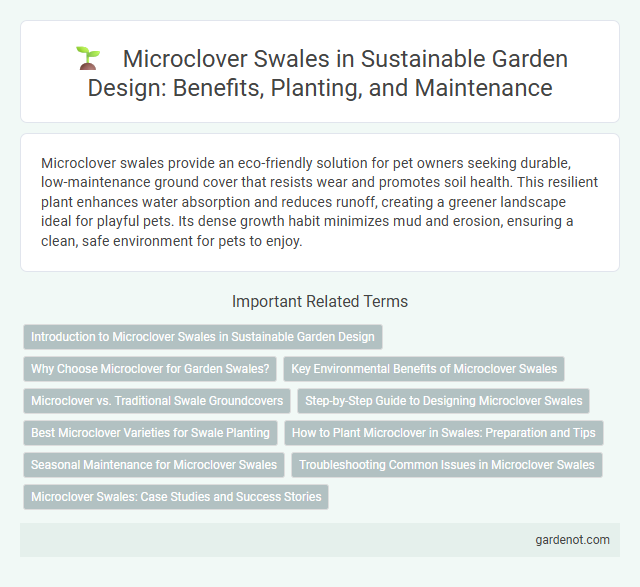Microclover swales provide an eco-friendly solution for pet owners seeking durable, low-maintenance ground cover that resists wear and promotes soil health. This resilient plant enhances water absorption and reduces runoff, creating a greener landscape ideal for playful pets. Its dense growth habit minimizes mud and erosion, ensuring a clean, safe environment for pets to enjoy.
Introduction to Microclover Swales in Sustainable Garden Design
Microclover swales integrate microclover ground cover with swale trenches to enhance water retention and prevent soil erosion in sustainable garden design. This combination promotes nitrogen fixation, improving soil fertility while supporting native plant growth and reducing irrigation needs. Microclover's dense canopy suppresses weeds, creating low-maintenance, eco-friendly landscapes optimized for stormwater management and environmental resilience.
Why Choose Microclover for Garden Swales?
Microclover offers exceptional benefits for garden swales due to its deep root system that enhances soil structure and improves water infiltration, reducing runoff and erosion. Its nitrogen-fixing capability naturally enriches the soil, promoting healthier plant growth without the need for synthetic fertilizers. Microclover's dense, low-growing habit also suppresses weeds and requires less mowing, making it an eco-friendly and low-maintenance choice for sustainable landscaping.
Key Environmental Benefits of Microclover Swales
Microclover swales enhance stormwater management by increasing water infiltration and reducing surface runoff, which minimizes erosion and nutrient loss. Their dense root systems improve soil structure and support microbial diversity, promoting healthier ecosystems. Microclover's natural nitrogen-fixing ability reduces the need for synthetic fertilizers, contributing to lower greenhouse gas emissions and improved water quality.
Microclover vs. Traditional Swale Groundcovers
Microclover in swale applications offers superior drought tolerance and nitrogen-fixing properties compared to traditional grass groundcovers, reducing fertilizer needs and enhancing soil health. Its low-growing, dense mat improves erosion control while requiring less mowing and maintenance, making it a cost-effective solution for stormwater management. The deep root system of microclover promotes better water infiltration and resilience in varying climates versus conventional swale vegetation.
Step-by-Step Guide to Designing Microclover Swales
Designing microclover swales begins with site assessment to identify slope, soil type, and drainage patterns critical for optimal water retention. Excavation follows, creating shallow, contoured trenches that maximize runoff capture and infiltration, then layering the base with compost-enriched soil to support microclover growth. Planting microclover seeds or plugs along the swale stabilizes soil, reduces erosion, and enhances nitrogen fixation, improving overall soil fertility and swale performance.
Best Microclover Varieties for Swale Planting
Microclover varieties such as Dutch White and Ladino are ideal for swale planting due to their drought tolerance, nitrogen-fixing ability, and low growth habit, which enhances soil stabilization and reduces erosion. These microclover types improve water retention and nutrient cycling, making them perfect for sustainable swale ecosystems. Selecting disease-resistant cultivars like Dutch White ensures long-term durability and minimal maintenance in swale applications.
How to Plant Microclover in Swales: Preparation and Tips
To plant Microclover in swales, begin by thoroughly preparing the soil through aeration and removing debris to improve drainage and root penetration. Use a seed spreader to evenly distribute microclover seeds at a rate of approximately 2 to 3 pounds per 1,000 square feet, then lightly rake the soil to ensure good seed-to-soil contact. Maintain consistent moisture during germination and establish a mowing regimen of 2 to 3 inches to encourage dense, healthy growth and nitrogen fixation in the swale environment.
Seasonal Maintenance for Microclover Swales
Seasonal maintenance for microclover swales involves regular inspection to ensure proper water infiltration and prevent erosion, especially during rainy seasons. Managing weed growth and occasional reseeding are essential to maintain dense ground cover that supports soil stabilization and nutrient cycling. Fertilization with low-nitrogen blends tailored for microclover enhances its nitrogen-fixing properties, promoting sustainable, eco-friendly swale performance throughout the year.
Troubleshooting Common Issues in Microclover Swales
Microclover swales may face challenges such as poor drainage, weed invasion, and uneven growth. Addressing drainage issues involves ensuring proper grading and soil aeration to prevent waterlogging. Regular monitoring and integrated weed management strategies help maintain healthy microclover coverage and optimize swale performance.
Microclover Swales: Case Studies and Success Stories
Microclover swales have demonstrated significant improvements in soil stabilization and water retention in various urban landscaping projects, leading to reduced erosion and enhanced biodiversity. Case studies in temperate climates reveal that integrating microclover into swale designs increases nitrogen fixation, promoting healthier vegetation growth without synthetic fertilizers. Success stories highlight microclover swales' role in sustainable stormwater management, effectively filtering runoff while supporting pollinators and reducing maintenance costs.
Microclover swale Infographic

 gardenot.com
gardenot.com